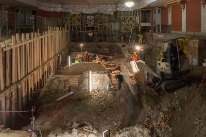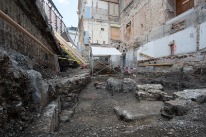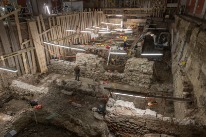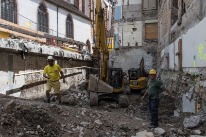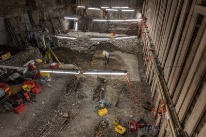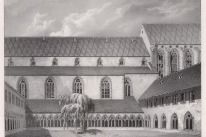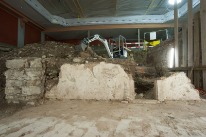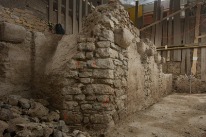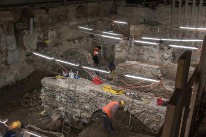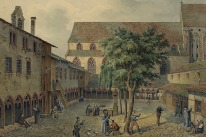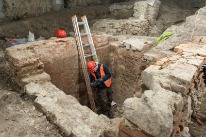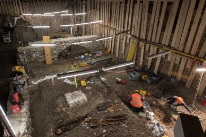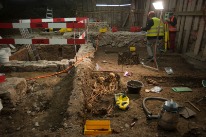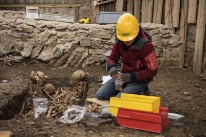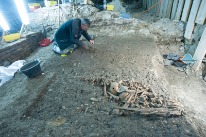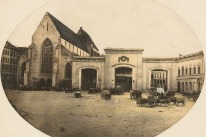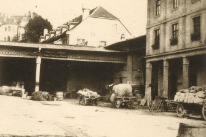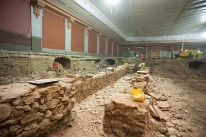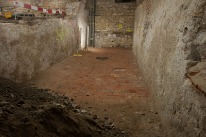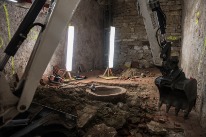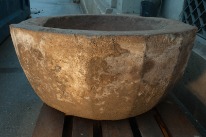Basel, AD 1300 - The cloister of the Barfüsserkloster (Franciscan friary)
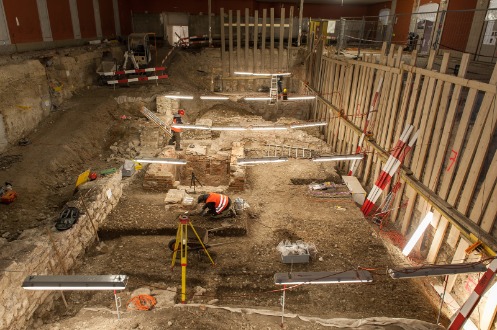
Steinenberg 14, November 2016
Why are we excavating?
The planned extension and renovation of the Stadtcasino has prompted extensive rescue excavations, which will be carried out over the next 12 months. The excavations commenced on 18th October in the music hall, where they will reach a depth of 7 metres below the former parquet flooring.
The location of the Stadtcasino is extremely interesting from the point of view of the city’s history. The development and expansion of the city over several centuries can be traced here.
What do we expect to find?
The Barfüsserkirche church and the Barfüsserplatz square are located today in the centre of Grossbasel (the area of Basel on the left bank of the River Rhine). Up until the mid-13th century, the area was still situated on the edge of the city. Nevertheless, it was intensively used:
The 10th century settlement has so far only been identified by means of ceramic finds and hearths. The Burkhard city wall ran through the area and the first church was built here at the end of the 11th century. The Stadtcasino grounds, however, were still outside the fortification at that time. Construction of the inner city wall in the early 13th century led to the first expansion of Basel, which enclosed the area within the new ring wall.
Around AD 1250 the Franciscans built the first friary. Some 50 years later, this edifice was replaced by a new building, of which the Barfüsserkirche church still stands today. The cloister and associated friary buildings were located in the area of the present-day Stadtcasino. Several phases of alteration and reuse followed after the Reformation period until the 19th century (e.g. hospital). In 1844, the former friary buildings were finally replaced by a department store and the music hall of the Stadtcasino was built in 1875.
How long will the excavations take?
The excavations are set to continue until the end of October 2017. Unfortunately, there aren't guided tours any more.
Results:
Basel, AD 1300 - Franciscan friary
The excavation uncovered the remains of the south and west wing of the cloister and a section of the cloister-garth of the Barfüsserkloster (Franciscan Friary).
The cemetery in the cloister garden
Since October 2016 more than 260 skeletons have been uncovered in the cloister garden of the former Franciscan friary. From infants to the elderly, all age groups are present.
From 1528 onwards, the cloister and garth became part of the newly founded “lunatic asylum” or almshouse. Anatomical interventions – six skulls with boreholes (trepanations) and one with an incision – show that inmates from the almshouse were also buried there. A gold coin, together with the trepanations and the dress accessories from other graves, provides valuable indications that the burials in the cloister garden date to the time after the Reformation.
Basel, AD 1844 - departement store
In 1843 the monastic buildings were demolished and replaced by a department store. Despite its name, the so-called department store, built in 1844 beside the Barfüsserkirche church, did not serve as a market for the general public but as a place for the wholesale of goods and where customs and excise duty was paid.

